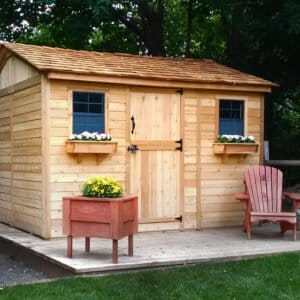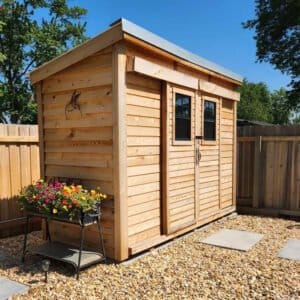No products in the cart.
November 21, 2015
 A shed is usually a structure to have in your garden. While your garden shed can withstand and endure spring, summer, and fall effortlessly, it does require some help to endure the harsh winter months. You will be using your garden shed less in the winter and hence, you will not know of any seasonal damage until spring. So it is an astute idea to winterize your shed, so that it stays sturdy and pristine during the winter, ready to welcome you when spring arrives in all its glory.So how do you winterize your shed? Are there some special measures that you need to adopt? Yes, there are few things you need to do in the fall to help prop up the shed for winter.
A shed is usually a structure to have in your garden. While your garden shed can withstand and endure spring, summer, and fall effortlessly, it does require some help to endure the harsh winter months. You will be using your garden shed less in the winter and hence, you will not know of any seasonal damage until spring. So it is an astute idea to winterize your shed, so that it stays sturdy and pristine during the winter, ready to welcome you when spring arrives in all its glory.So how do you winterize your shed? Are there some special measures that you need to adopt? Yes, there are few things you need to do in the fall to help prop up the shed for winter.Thorough Cleaning
Your shed becomes a place to store everything, from pots, lawn mower, fertilizer, mulch, garden hose to gardening tools, and accessories. Before you decide to shut your shed for winter, it makes sense to organize your shed. Otherwise in the spring you will find critters and varmints enjoying themselves. Also, when you clean the shed and everything inside it, you can be spring ready.- Remove all the things outdoors to sort out what you need and what has to be disposed. Broken pots, spare parts and some extra materials, and other damaged items that can’t be used or that is needed should be discarded.
- Sweep the floor and remove any cobwebs. Get rid of insects that may have made their home in the shed in the summer. Use poison if you have too.
- Clean the gardening tools properly and store them in plastic bags, so that you have them ready for spring.
- Empty out the contents of the garden hose and then roll it to store away properly to prevent it from cracking or getting damaged in extreme temperatures.
- Remove oil and gas from the leaf blower, lawn mower and trimmer. Cover them with a tarp to prevent moisture and dust getting to them.
- Place potting soil, fertilizer, mulch, and grass seed in individual plastic bags and secure them. This will keep rodents from nesting in them and doing even worse things.
- Oil, thinners, fuel, and paint should be disposed in an environmentally-safe manner. So call a local disposal company to do that on your behalf.
- Secure the electrical cords to each electrical tool to prevent them from getting entangled with other things.
Inspect and Repair the Interior of the Shed
 When you empty out the shed and after you finish cleaning the floor and walls, it is time to inspect the interiors of the shed and make necessary repairs.Check the floor, ceiling and walls carefully. If you notice holes and crevices, use caulk to fill them in. This will prevent pests from getting inside your shed in winter.Look behind shelves, hooks and other wall-mounted hangings for damage. If you notice anything, repair it immediately.Carefully check the seals around windows and doors. If you notice cracks or damaged weatherstripping, replace it. Otherwise, cold air and moisture will make their way into the shed. Oil the door hinges, so that they function optimally even during winter.If you have the energy and money, give the walls a fresh coat of paint to renew the appearance.Waterproof the floor to enhance its longevity if you intend using winter tools. The wet tools can damage wooden flooring.
When you empty out the shed and after you finish cleaning the floor and walls, it is time to inspect the interiors of the shed and make necessary repairs.Check the floor, ceiling and walls carefully. If you notice holes and crevices, use caulk to fill them in. This will prevent pests from getting inside your shed in winter.Look behind shelves, hooks and other wall-mounted hangings for damage. If you notice anything, repair it immediately.Carefully check the seals around windows and doors. If you notice cracks or damaged weatherstripping, replace it. Otherwise, cold air and moisture will make their way into the shed. Oil the door hinges, so that they function optimally even during winter.If you have the energy and money, give the walls a fresh coat of paint to renew the appearance.Waterproof the floor to enhance its longevity if you intend using winter tools. The wet tools can damage wooden flooring.Give the Roof Special Treatment
The roof of your shed also requires TLC. Remember, it will be exposed to strong winter winds and snowfall (depending on where you live). It should be sturdy enough to withstand the elements and keep moisture away from the interior.- If the shed has metal roof, there will be areas that are rusted. Clean the roof thoroughly and rustproof it.
- Shingled roof also requires proper maintenance to prep it for winter. Replace loose shingles and replace any that is broken.
- If you have a wooden roof, look for wood warping, boring insects, and cracked panels. You will want to replace panels that are damaged and also treat the wood to prevent insects from boring into it. Western Red Cedar panels that are often used in DIY garden shed kits are naturally resistant to pests and are awesome for outdoor sheds.
- Replace rusted nails and reinforce loose panels properly.
- Trim overhanging branches from trees, as they can damage your garden shed once they get heavy with ice and snow.
Fix and Repair the Exterior
Check the exterior of your shed carefully. Look for holes and crevices and fill them up. If you like, you can paint the exterior with waterproof paint to protect it from moisture. Remember, if you are painting, let the paint dry properly between coats. Remove growth from around the shed as efficiently as possible.Use these tips to winterize your backyard shed. It may sound like a lot of work, but if you plan on doing a little bit every day, you should have your garden shed ready for winter within no time. Winterizing your shed will boost its longevity and you will not have to worry about repairs (or profound ones) when spring arrives.November 21, 2015
-
 On SaleSale!%Off7Save $430430$7%430$On SaleSale!%Off5Save $340340$5%340$On SaleSale!%Off2Save $155155$2%155$On SaleSale!%Off6Save $414414$6%414$On SaleSale!%Off2Save $130130$2%130$On SaleSale!%Off2Save $132132$2%132$On SaleSale!%Off7Save $430430$7%430$
On SaleSale!%Off7Save $430430$7%430$On SaleSale!%Off5Save $340340$5%340$On SaleSale!%Off2Save $155155$2%155$On SaleSale!%Off6Save $414414$6%414$On SaleSale!%Off2Save $130130$2%130$On SaleSale!%Off2Save $132132$2%132$On SaleSale!%Off7Save $430430$7%430$ -
 On SaleSale!%Off26Save $130130$26%130$On SaleSale!%Off26Save $130130$26%130$
On SaleSale!%Off26Save $130130$26%130$On SaleSale!%Off26Save $130130$26%130$ -
 On SaleSale!%Off17Save $205205$17%205$On SaleSale!%Off17Save $205205$17%205$
On SaleSale!%Off17Save $205205$17%205$On SaleSale!%Off17Save $205205$17%205$ -
 On SaleSale!%Off7Save $339339$7%339$On SaleSale!%Off6Save $260260$6%260$On SaleSale!%Off11Save $485485$11%485$On SaleSale!%Off11Save $485485$11%485$
On SaleSale!%Off7Save $339339$7%339$On SaleSale!%Off6Save $260260$6%260$On SaleSale!%Off11Save $485485$11%485$On SaleSale!%Off11Save $485485$11%485$ -
 On SaleSale!%Off8Save $155155$8%155$On SaleSale!%Off10Save $190190$10%190$On SaleSale!%Off10Save $190190$10%190$
On SaleSale!%Off8Save $155155$8%155$On SaleSale!%Off10Save $190190$10%190$On SaleSale!%Off10Save $190190$10%190$ -
 On SaleSale!%Off19Save $1,8201820$19%1820$On SaleSale!%Off19Save $1,8201820$19%1820$
On SaleSale!%Off19Save $1,8201820$19%1820$On SaleSale!%Off19Save $1,8201820$19%1820$










